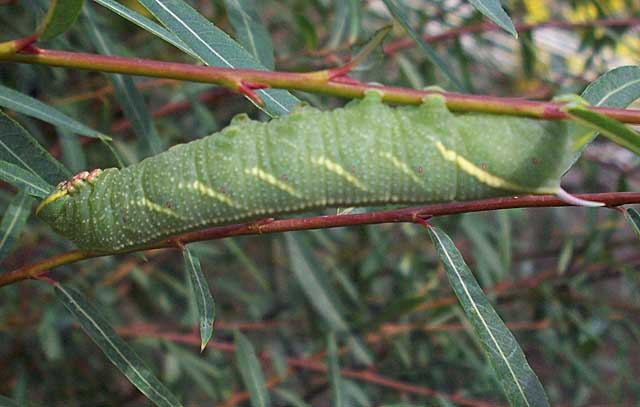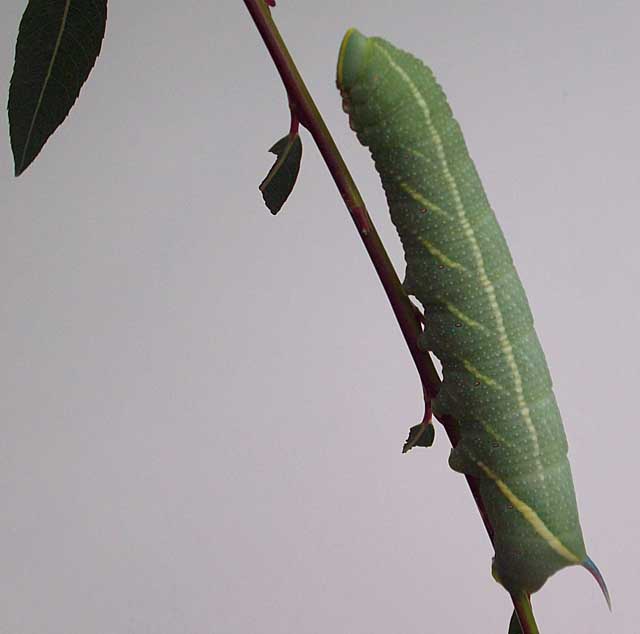Linn County, Oregon and other Northwestern Counties
Sphingidae Larvae
Smerinthus ophthamlmica on purple osier willow (Salix purpurea), Albany, Linn County, Oregon,
September 10, 2009, courtesy of Kris Watts.
|
|
Updated as per James P. Tuttle's The Hawk Moths of North America, September 10, 2009 Updated as per personal communication with Kris Watts, September 10, 2009 |

Smerinthus ophthamlmica on purple osier willow (Salix purpurea), Albany, Linn County, Oregon,
September 10, 2009, courtesy of Kris Watts.
Kris writes, "I found your website after doing a search on a caterpillar I found on my purple osier willow (Salix purpurea). I am pretty sure it is a Smerinthus cerisyi (corrected to S. ophthalmica) larva. I am located in Albany, Oregon and I found it just today, Sept. 10. I am also sending 2 photos. I have not noticed the moth around, however. I hope this helps with your data base. Please let me know if I have identified this guy correctly. Thanks!."
Congratulations to Kris for a correct(ed) id!
For care of "found larvae/caterpillars" visit Manduca sexta larva, central Texas, August 21, 2008, Trina Woodall.
Only twenty-three Sphingidae species are listed for Oregon on the U.S.G.S. website (now BAMONA. Not all of the species are reported or anticipated in Linn County. It is hoped that this checklist, with the thumbnails and notes, will help you quickly identify the larvae you are likely to encounter.
I expect the sames species would likely also be present in Clatsop, Multnomah, Columbia, Hood River, Tillamook, Clackamas, Yamill, Marion, Washington and Linn counties, so this checklist will also serve for those counties although the official documentation at this time is only for Linn County.
A "WO" after the species name indicates that I have no confirmed reports of this species in your county, but I (William Oehlke) expect that this moth with its larvae are present or might be present.
A "USGS" indicates the moth is reported in Lepidoptera of North America, #1. Distribution of Silkmoths (Saturniidae) and Hawkmoths (Sphingidae) of Eastern North America, an excellent little booklet available through Paul Opler.
Please help me develop this list with improved, documented accuracy by sending sightings (species, date, location), preferably with an electronic image, via email to Bill Oehlke.
You can visit additional Sphingidae checklists for adult moths and caterpillars for all US states and Canadian provinces at
Sphinx Nations. There are also checklists for all North, Central, South American and Carribean countries via links at same site.
You can visit pictoral checklists for Catocala (underwing moths) for all US states and Canadian provinces at
North American Catocala.
Sphinginae subfamily
Smerinthini Tribe:
Macroglossinae subfamilyDilophonotini tribe:
Philampelini tribe:
Macroglossini tribe:
|

Smerinthus ophthalmica on purple osier willow (Salix purpurea), Albany, Linn/Benton County, Oregon,
September 10, 2009, courtesy of Kris Watts.
Enjoy some of nature's wonderments, giant silk moth cocoons. These cocoons are for sale winter and fall. Beautiful Saturniidae moths will emerge the following spring and summer. Read Actias luna rearing article. Additional online help available.
Eggs of many North American species are offered during the spring and summer. Occasionally summer Actias luna and summer Antheraea polyphemus cocoons are available. Shipping to US destinations is done from within the US.
Use your browser "Back" button to return to the previous page.
This page is brought to you by Bill Oehlke and the WLSS. Pages are on space rented from Bizland. If you would like to become a "Patron of the Sphingidae Site", contact Bill.
Please send sightings/images to Bill. I will do my best to respond to requests for identification help.
 Show appreciation for this site by clicking on flashing butterfly to the left. The link will take you to a page with links to many insect sites. |
I very much appreciate all the many images that have been sent to me, or of which I have been granted permission to copy and post from other websites. All images on this site remain the property of respective photographers.
If you would like to contribute to the maintenace of this website by sending a contribution to
Bill Oehlke
Box 476
155 Peardon Road
Montague, Prince Edward Island, C0A1R0
Canada
your donation would be much appreciated and would be used for
1) paying for webspace rental;
2) paying for computer maintenance and software upgrades;
3) purchases of additional text reference material (journals and books) in anticipation of expanding the site to a worldwide Sphingidae site;
4) helping to pay my daughter's tuition; with anything left over going to humanitarian aid.
If you are mailing a check from USA, please use $1.25 postage (2017 postal rate). Donations can also be made through Paypal via the button below.